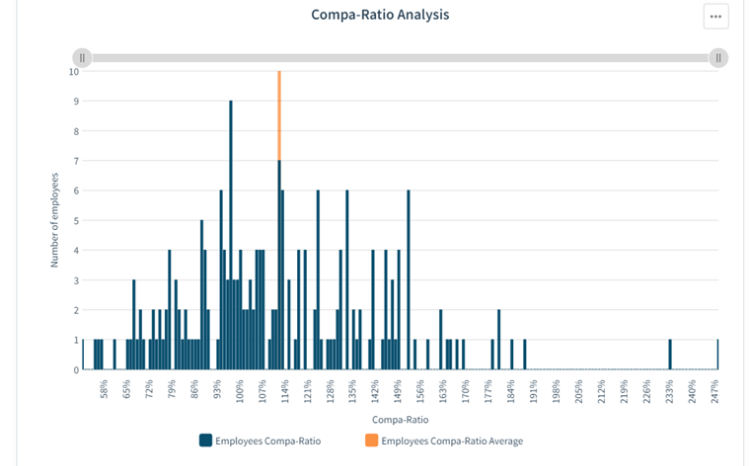For most businesses, salaries are often the largest line item in the budget—so it’s no surprise they’re often under the microscope. And if they’re not, they certainly should be. The starting point? Understanding your salary data.
Once you’ve gathered this crucial information, the next step is to calculate compa-ratios. Don’t worry, it’s easier than it sounds. A compa-ratio (short for compensation ratio) is the result of dividing an individual’s salary by the midpoint of the salary range for their role, then multiplying by 100:
Current salary/market average x 100
So, let’s assume for a moment that the median salary of a software engineer role is 85,000€. Your most recently hired software engineer is on a salary of €80,000. How does this measure up as a compa-ratio? Well, if we divide €80,000 by the market average and multiply by 100, we get a value of 94. If we express this as a percentage - 94% - we can see that your latest hire is being paid slightly below average.
What does the compa-ratio tell us?
Compa-ratio percentages generally fall between 80% and 120%, with 100% being considered the market value. New hires tend to be paid compensation at the lower end of this spectrum to give them room to grow, whilst longer-serving employees and those with exceptionally in-demand profiles might earn salaries closer to the top mark.
What’s next?
Calculating a compa-ratio allows you to see the facts, the current practices. The value comes when you go on to analyze future compensation decisions.
Firstly, compa-ratios are an objective decision-making tool for establishing fair, consistent salaries for employees. They provide a simple mathematical indication of what people in the same role - but perhaps with different levels of experience, tenure, and responsibilities - actually earn.
The expectation would be that someone with the appropriate level of skills, experience and qualifications would reveive a 100% compa-ratio, while more established professionals would receive a higher compa-ratio. If this isn’t the case, organizations can assess and - if necessary - consider making salary adjustments if necessary.
Next, compa-ratios provide invaluable insight into pay equity. Analysts can compare the average ratio of any subgroup to the group average to identify differences between groups.
Identifying these differences allows you to tackle pay inequality. By calculating a compa-ratio for men in an organization, and doing the same for women, companies can see if they have a gender pay gap. A situation where men are at 100% and women are somewhere in the 90s would indicate an immediate need to find the root cause.
Compa-ratios are also a valuable tool for determining new-hire salaries. If an organization is looking to hire people with a few years of experience, offering a salary above the median is ideal. On the other hand, offering less than 100% may work if you are recruiting junior staff who are expected to grow with the company.
Ultimately, compa-ratios are a neat, tangible metric that can be used to ensure an organization is on the right track when it comes to pay. After all, there are big implications for companies that are way off track.
Consistently achieving double-digit scores? An organisation will struggle to attract and retain top talent. Massively over 100%? Annual budgets could be seriously stretched.




